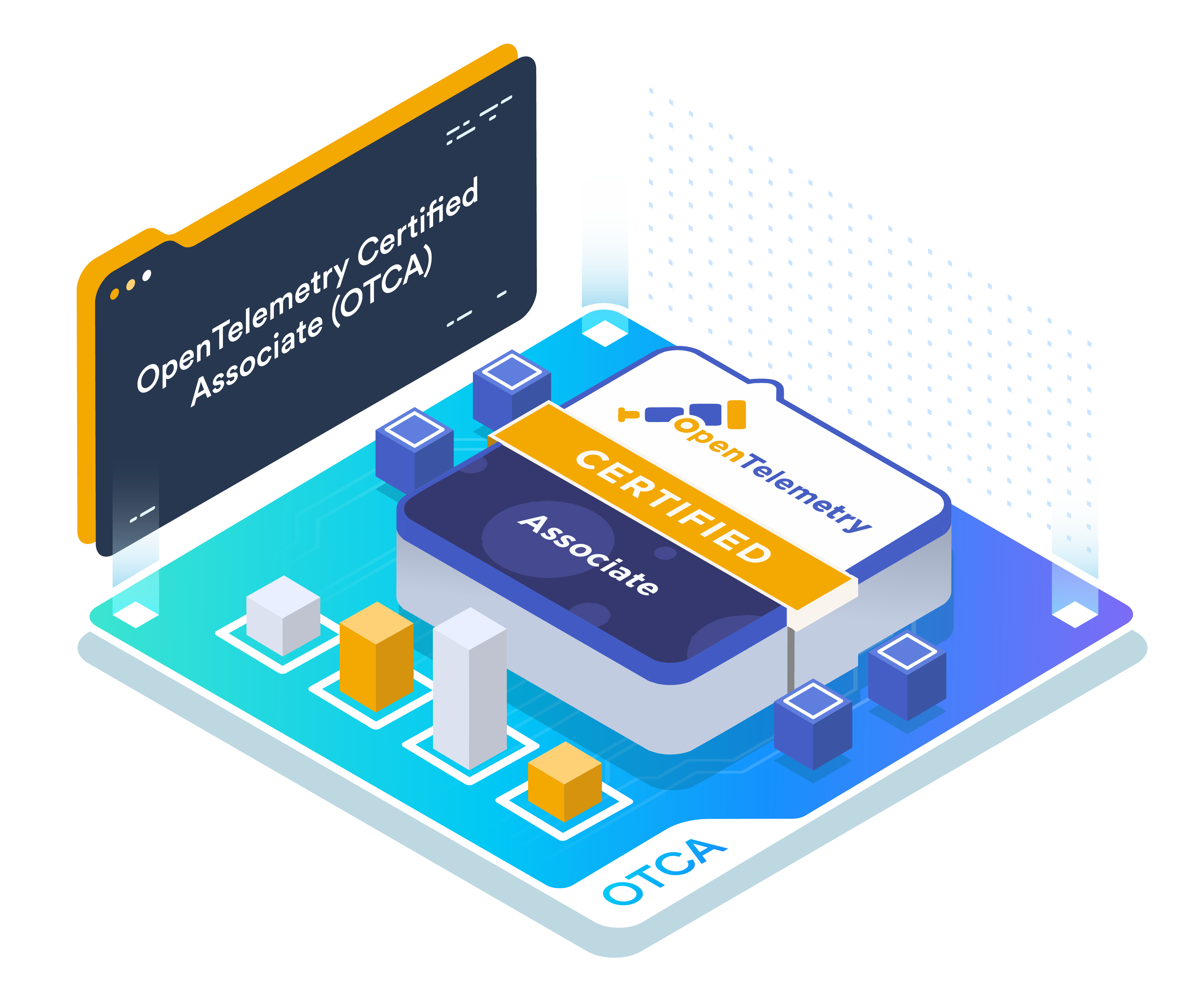What you’ll learn
Our students work at..







Description
Welcome to the OpenTelemetry Certified Associate (OTCA) Certification Course!
Modern applications are distributed across clouds, containers, and services — making it nearly impossible to ensure reliability and performance without observability.
OpenTelemetry has emerged as the open-source standard for collecting, processing, and exporting telemetry data, empowering organizations to achieve end-to-end visibility across their systems.
This comprehensive course prepares you for the OpenTelemetry Certified Associate (OTCA) exam while helping you develop the hands-on skills to implement observability using OpenTelemetry in real-world environments. Through detailed lessons, live demos, hands-on labs, and real-world use cases, you’ll gain a deep understanding of how to collect traces, metrics, and logs from distributed systems and integrate them with popular observability tools.
Course Modules
Observability Core Concepts
Build a solid foundation in observability by understanding how modern distributed applications work, the difference between monitoring and observability, and why standardization through OpenTelemetry was the missing piece in modern system reliability.
OpenTelemetry Core Concepts
Explore OpenTelemetry’s goals, mission, and vision while diving deep into its architecture, semantic conventions, core components, API, and specification standards. Understand how the OpenTelemetry protocol (OTLP) enables seamless interoperability and gain insights into the end-to-end telemetry pipeline.
Span Anatomy and Context Propagation
Master distributed tracing fundamentals by understanding spans, span kinds, context propagation, and attributes. Learn to connect multiple services, propagate context across them, and analyze traces using real-world demos and labs.
Instrumentation
Discover how to instrument applications manually and automatically to generate telemetry data. Learn about span processors, exporters, resource attributes, and sampling strategies through practical demonstrations in multiple programming languages, including Python and Java.
Metrics Data Model
Understand the role of metrics in observability and learn about the structural properties of metrics — such as monotonicity, temporality, and aggregation. Explore the OpenTelemetry metrics data model, instruments, and data flow to gain complete control over metric collection.
Recording Measurements
Get hands-on with the OpenTelemetry Metrics API and SDK. Learn about metric lifecycles, views, and exemplars while recording real-time measurements. Practice with demos and labs to build, visualize, and export metrics using tools like Prometheus.
Logs
Learn how OpenTelemetry handles logging across distributed systems. Explore the logging data model, APIs, SDKs, and integrations with tracing. Through demos and labs, you’ll instrument logs, export them via the OpenTelemetry Collector, and correlate them with trace data for full-stack observability.
OTel Collector Foundations
Understand the purpose and architecture of the OpenTelemetry Collector. Learn installation methods, configuration fundamentals, and distribution models. Through guided demos and labs, deploy and configure the Collector on various environments including Docker and Kubernetes.
OTel Collector Core Components
Deep dive into the Collector’s key building blocks — receivers, processors, exporters, and connectors. Learn to configure and optimize telemetry pipelines, apply best practices for resiliency, and integrate with backends like Jaeger and Prometheus through detailed demos and labs.
Transforming Telemetry – Pipeline Processing
Gain expertise in transforming and filtering telemetry data using the OpenTelemetry Transformation Language (OTTL). Learn to apply filtering, attribute transformation, and sampling strategies like head and tail sampling. Understand schema fundamentals and translation rules to maintain data consistency across observability systems.
OpenTelemetry in Kubernetes
Discover how to deploy and manage OpenTelemetry within Kubernetes environments. Learn about the OpenTelemetry Operator, auto-instrumentation techniques, key Kubernetes receivers, and Collector deployment modes. Practice these concepts through interactive demos and hands-on Kubernetes labs.
OpenTelemetry Collector: Debugging, Operations and Scaling
Learn to operate and scale the OpenTelemetry Collector in production. Understand debugging techniques, internal diagnostics, health checks, and performance profiling using zPages and pprof. Explore strategies for horizontal scaling, resilience, and troubleshooting telemetry pipelines efficiently.
Hands-On Labs and Real-World Projects
- Instrument applications and services to generate traces, metrics, and logs.
- Deploy and manage OpenTelemetry Collectors in real Kubernetes clusters.
- Configure complete observability pipelines and visualize telemetry data using open-source tools.
Mock Exams and Exam Readiness
To help you succeed, the course includes mock exams that mirror the structure, coverage, and difficulty of the official OTCA certification. These practice tests will reinforce your knowledge, assess your readiness, and boost your confidence for the real exam.
About This Certification
The OpenTelemetry Certified Associate (OTCA) is a foundational certification that validates your understanding of observability principles, OpenTelemetry architecture, and telemetry data handling across distributed systems.
Earning this certification demonstrates your ability to implement, configure, and maintain OpenTelemetry-based observability solutions at scale.
Who Should Enroll
- Observability, DevOps, and Site Reliability Engineers (SREs).
- Cloud and Platform Engineers working with distributed systems.
- Developers and Architects integrating telemetry into applications.
- Anyone preparing for the OpenTelemetry Certified Associate (OTCA) exam.
Prerequisites
- Basic knowledge of Kubernetes and cloud-native applications.
- Familiarity with application performance monitoring and YAML configuration.
- Understanding of distributed systems concepts is beneficial but not mandatory.
Empower your observability journey with OpenTelemetry — enroll today and become a Certified OpenTelemetry Associate! 🚀
What our students say
.png)
About the instructor
Amrith Raj is an Observability Advocate and the Lead Solutions Architect at a leading Observability company, where he supports the transformation journeys of diverse global customers through automated and intelligent observability solutions.He has authored an e-book on cloud capacity and published several papers on cloud computing, data centres, and IT infrastructure. As part of the Cloud Use Cases Group, Amrith co-authored the whitepaper “Moving to Cloud”—a pioneering work published at a time when cloud adoption was still in its early stages.Throughout his career, Amrith has held multiple roles spanning leadership, engineering, operations, modernisation, cloud architecture, automation, migration, and the design of fault-tolerant cloud infrastructures.Based in Melbourne, he is passionate about leveraging technology to transform human lives and drive meaningful innovation.
.svg)


.svg)
.svg)


.png)




